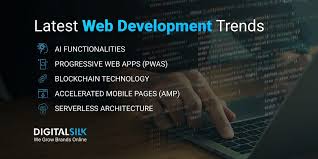The Latest in Website Technology: A Glimpse into the Future
As the digital landscape continues to evolve, website technology is advancing at an unprecedented rate. From enhanced user experiences to improved security measures, the latest technologies are reshaping how websites are designed, developed, and interacted with. This article explores some of the most exciting advancements in website technology that are setting new standards for online innovation.
Progressive Web Apps (PWAs)
Progressive Web Apps have become a game-changer for web developers and businesses alike. PWAs combine the best features of web and mobile applications, providing users with a seamless experience. They offer offline access, fast loading times, and push notifications without requiring users to download an app from an app store. As a result, PWAs are becoming increasingly popular for businesses looking to enhance user engagement and improve performance across all devices.
Responsive Design 2.0
While responsive design is not new, its evolution continues to be pivotal in web development. The latest iteration focuses on creating designs that adapt not only to screen size but also to user preferences and environmental conditions. By leveraging technologies like CSS Grid and Flexbox, developers can create layouts that automatically adjust for optimal viewing experiences across diverse devices and orientations.
Artificial Intelligence (AI) Integration
The integration of Artificial Intelligence into websites is revolutionising how businesses interact with their customers. AI-driven chatbots provide instant customer support, while machine learning algorithms personalise content delivery based on user behaviour. Additionally, AI tools can analyse vast amounts of data to optimise website performance and enhance decision-making processes.
Voice Search Optimisation
With the rise of smart speakers and voice assistants like Amazon Alexa and Google Assistant, optimising websites for voice search has become essential. Voice search optimisation involves structuring content in a way that aligns with natural language queries. This includes using conversational keywords and answering common questions directly within content to improve visibility in voice search results.
Enhanced Cybersecurity Measures
As cyber threats become more sophisticated, robust cybersecurity measures are critical for protecting sensitive information online. The latest advancements include implementing HTTPS protocols across all pages, utilising advanced encryption techniques, and adopting multi-factor authentication methods to safeguard user data.
The Rise of No-Code/Low-Code Platforms
No-code and low-code platforms have democratized web development by allowing individuals without extensive coding knowledge to create functional websites quickly. These platforms offer drag-and-drop interfaces that simplify the design process while still providing customisation options for more advanced users.
The Future Awaits
The future of website technology promises even more exciting developments as emerging technologies continue to push boundaries. From augmented reality experiences integrated into e-commerce sites to blockchain-based solutions enhancing transparency and trustworthiness—innovation knows no bounds.
Staying abreast of these trends will be crucial for businesses seeking a competitive edge in today’s digital world. By embracing these cutting-edge technologies now rather than later—businesses can ensure they remain at the forefront of this ever-evolving landscape.
Exploring the Latest Innovations in Website Technology: Key FAQs Answered
- What are Progressive Web Apps (PWAs) and how do they benefit websites?
- How can responsive design 2.0 improve user experiences on websites?
- What role does Artificial Intelligence play in modern website technology?
- Why is voice search optimisation important for websites in the current digital landscape?
- What cybersecurity measures should websites implement to protect user data in today’s online environment?
What are Progressive Web Apps (PWAs) and how do they benefit websites?
Progressive Web Apps (PWAs) are a revolutionary advancement in website technology that combines the best features of web and mobile applications. PWAs offer users a seamless experience by providing offline access, fast loading times, and push notifications without the need to download an app from an app store. These apps are designed to be responsive across all devices and platforms, ensuring a consistent user experience. The benefits of PWAs for websites are manifold—they enhance user engagement, improve performance, increase conversion rates, and boost overall user satisfaction. By leveraging the capabilities of PWAs, websites can deliver app-like experiences while maintaining the reach and accessibility of traditional websites.
How can responsive design 2.0 improve user experiences on websites?
Responsive Design 2.0 represents a significant advancement in web development, offering a more sophisticated approach to enhancing user experiences on websites. By leveraging technologies such as CSS Grid and Flexbox, Responsive Design 2.0 ensures that websites not only adapt seamlessly to various screen sizes but also consider user preferences and environmental conditions. This level of adaptability results in improved readability, faster loading times, and a more intuitive navigation experience for users across different devices. With Responsive Design 2.0, websites can deliver content in a visually appealing and user-friendly manner, ultimately leading to higher engagement levels and overall satisfaction among visitors.
What role does Artificial Intelligence play in modern website technology?
Artificial Intelligence (AI) plays a pivotal role in modern website technology by enhancing user experience, personalising content, and streamlining operations. AI-powered chatbots provide instant customer support, handling queries efficiently and improving customer satisfaction. Machine learning algorithms analyse user behaviour to deliver tailored content and product recommendations, increasing engagement and conversion rates. Additionally, AI tools can optimise website performance by predicting user needs and automating routine tasks, allowing developers to focus on more complex issues. Overall, AI integration not only boosts the functionality of websites but also helps businesses gain valuable insights into their audience, enabling more informed decision-making.
Why is voice search optimisation important for websites in the current digital landscape?
In the current digital landscape, voice search optimisation is crucial for websites due to the increasing prevalence of smart speakers and voice assistants. With more users relying on voice commands to search for information, products, and services, websites that are optimised for voice search have a competitive advantage in reaching their target audience. By structuring content to align with natural language queries and providing concise, relevant answers, websites can improve their visibility in voice search results and enhance user experience. Embracing voice search optimisation not only caters to the evolving preferences of tech-savvy consumers but also positions websites for greater discoverability and engagement in an era where convenience and efficiency are paramount.
What cybersecurity measures should websites implement to protect user data in today’s online environment?
In today’s online environment, websites must implement robust cybersecurity measures to safeguard user data effectively. Key protocols include ensuring all pages are encrypted with HTTPS to secure data transmission, implementing strong authentication methods like multi-factor authentication to verify user identities, regularly updating software and patches to address vulnerabilities, conducting thorough security audits and penetration testing to identify and mitigate potential risks, and educating users about best practices for creating secure passwords and recognising phishing attempts. By prioritising these cybersecurity measures, websites can enhance data protection and build trust with their users in an increasingly digital world.




